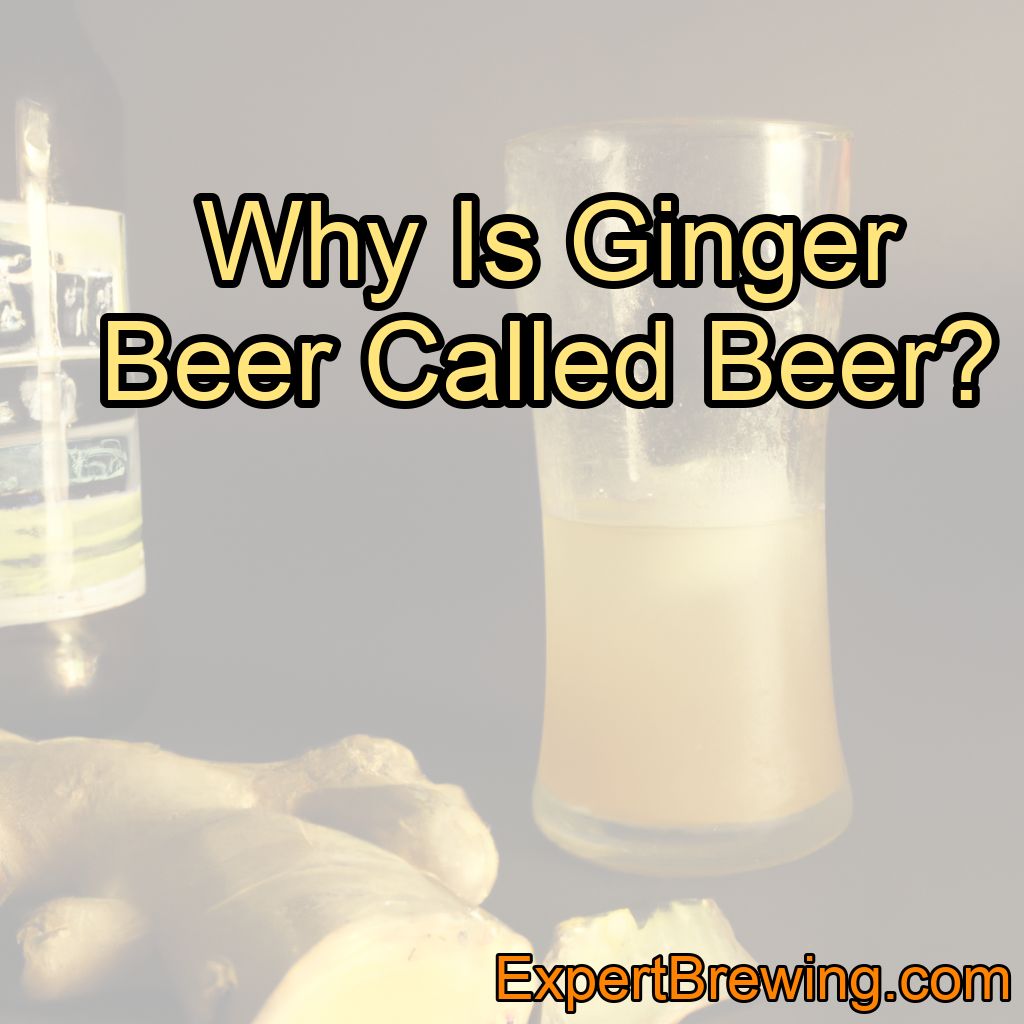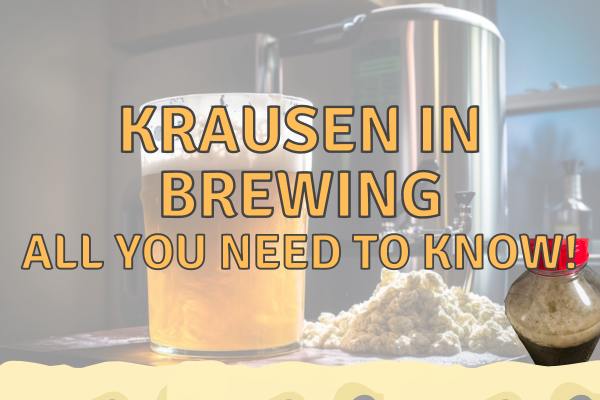Ginger beer is a refreshing, non-alcoholic beverage that has been enjoyed for centuries. Its tangy and spicy flavor, combined with its effervescence, make it a popular choice for people looking for a unique, flavorful drink.
But despite its name, ginger beer is not your typical beer. So, why is it called beer in the first place?
The term “ginger beer” is derived from its historical roots as a fermented beverage that shares some similarities with beer. However, ginger beer is non-alcoholic and made using a different fermentation process, making it a unique beverage in its own right.
In this blog post, we will explore the reasons behind the name “ginger beer,” delve into its history, discuss its health benefits, and even share a few recipes you can try at home. Let’s get started!
Why is it Called Beer?
Despite its non-alcoholic nature and unique fermentation process, ginger beer is still called “beer” due to its historical roots as a fermented beverage.
The term “small beer” was used to describe low-alcohol brews in the 18th century, and ginger beer was considered part of this category.
As the brewing process evolved and the alcohol content decreased, the name “ginger beer” remained, even though it no longer accurately describes its alcohol content.
The History of Ginger Beer
Ginger beer was first brewed in England in the 18th century. It was initially made by fermenting ginger, sugar, water, and a microorganism called a ginger beer plant (GBP).
This fermentation process created a beverage with a low alcohol content, ranging from 0.5% to 11% alcohol by volume (ABV). As a result, ginger beer was considered a “small beer,” similar to other low-alcohol beers of the time.
However, as ginger beer evolved over time, the fermentation process was adjusted to produce a non-alcoholic beverage. This change in production allowed ginger beer to be enjoyed by a wider audience, including children and those who preferred to avoid alcohol.
The Fermentation Process
The fermentation process of ginger beer is quite different from that of traditional beer. While both beverages rely on fermentation to produce their distinct flavors and carbonation, the specific microorganisms and methods used differ significantly.
Traditional beer is brewed using yeast, which converts the sugars in malted barley into alcohol and carbon dioxide. Ginger beer, on the other hand, uses a ginger beer plant, which is a symbiotic culture of bacteria and yeast (SCOBY) similar to the one used for making kombucha.
The ginger beer plant feeds on sugar and ginger, but produces very little alcohol, resulting in a non-alcoholic beverage.
Health Benefits of Ginger Beer
Ginger beer offers a variety of health benefits, thanks to its main ingredient: ginger. Ginger is known for its anti-inflammatory, antioxidant, and anti-nausea properties, which can provide relief from various ailments. Some of the health benefits associated with ginger beer include:
1. Aiding digestion: Ginger is known to soothe the digestive system and help with digestion, making ginger beer a great after-dinner drink.
2. Reducing nausea: Ginger’s anti-nausea properties can help alleviate morning sickness, motion sickness, and chemotherapy-induced nausea.
3. Boosting the immune system: The antioxidants in ginger can help strengthen the immune system and ward off infections.
4. Reducing inflammation: Ginger’s anti-inflammatory properties can help reduce joint pain and inflammation associated with arthritis.
In addition to its health benefits, ginger beer is also a source of probiotics, thanks to its fermentation process. Probiotics are beneficial bacteria that can improve gut health and overall well-being.
How is Ginger Beer Made?
Ginger beer is made using a ginger beer plant, which is a SCOBY that ferments the sugar and ginger to create the beverage. The basic recipe involves combining ginger, sugar, water, and the ginger beer plant in a jar or container, and allowing it to ferment for several days. During this time, the ginger beer plant consumes the sugar and ginger, creating carbon dioxide and giving the beverage its effervescence.
Once the fermentation process is complete, the ginger beer is strained to remove the solids and can be consumed immediately or bottled for later use.
Homemade Ginger Beer Recipes
If you’re interested in making your own ginger beer at home, there are several recipes you can try. Here are a few of our favorites:
1.Classic Ginger Beer: This recipe involves fermenting ginger, sugar, water, and ginger beer plant for 5-7 days. Once fermented, the ginger beer is strained and can be consumed or bottled for later use. This recipe creates a refreshing, non-alcoholic ginger beer with a spicy kick.
2.Alcoholic Ginger Beer: If you prefer a ginger beer with a bit of alcohol, you can try this recipe, which includes adding champagne yeast to the fermentation process. This will increase the alcohol content to around 2-4% ABV, giving your ginger beer a slightly more potent kick.
3.Fruity Ginger Beer: This recipe involves adding fresh fruit, such as pineapple or mango, to the fermentation process. The result is a deliciously fruity and refreshing ginger beer with a tropical twist.
Ginger Beer Cocktails
Ginger beer is a versatile mixer that can be used in a variety of cocktails. Its spicy and tangy flavor profile pairs well with various spirits and ingredients, making it an excellent addition to your home bar. Some popular ginger beer cocktails include:
1.Moscow Mule: A classic cocktail made with vodka, ginger beer, and lime juice, served in a copper mug.
2.Dark ‘n’ Stormy: A refreshing combination of dark rum, ginger beer, and lime juice.
3.Ginger Beer Margarita: A twist on the classic margarita, made with tequila, ginger beer, lime juice, and agave syrup.
Conclusion
Ginger beer is called “beer” due to its historical roots as a fermented beverage with a low alcohol content. However, modern ginger beer is non-alcoholic and made using a unique fermentation process, making it a distinct beverage in its own right.
Here are 10 facts about ginger beer you may find interesting:
1. Ginger beer was first brewed in England in the 18th century.
2. It was initially made with a low alcohol content, ranging from 0.5% to 11% ABV.
3. The fermentation process of ginger beer is different from traditional beer.
4. Ginger beer is made using a ginger beer plant, which is a SCOBY similar to the one used for making kombucha.
5. Ginger beer is non-alcoholic and typically has less than 0.5% ABV.
6. The health benefits of ginger beer include aiding digestion, reducing nausea, boosting the immune system, and reducing inflammation.
7. Ginger beer is a source of probiotics, thanks to its fermentation process.
8. Homemade ginger beer can be made using various recipes, including classic, alcoholic, and fruity versions.
9. Ginger beer is a versatile mixer that can be used in a variety of cocktails, such as Moscow Mules, Dark ‘n’ Stormies, and Ginger Beer Margaritas.
10. Despite its name, ginger beer is a unique and refreshing beverage that stands apart from traditional beer.
FAQs
Did ginger beer ever have alcohol?
Yes, traditionally ginger beer did contain a small amount of alcohol due to the fermentation process. However, modern commercial ginger beers are typically non-alcoholic.
What is ginger beer made of?
Ginger beer is made of ginger, sugar, water, and yeast.
Is there a difference between ginger ale and ginger beer?
Yes, there is a difference between ginger ale and ginger beer. Ginger ale is a carbonated soft drink flavored with ginger, while ginger beer is a more robust, spicy, and less sweet beverage made from fermented ginger, sugar, and water. Ginger beer also typically has a higher alcohol content than ginger ale.
Which is better for you ginger beer or ginger ale?
Ginger beer is generally considered to have a stronger ginger flavor and is less sweet than ginger ale, but both can be enjoyed in moderation as part of a balanced diet.
Was Victorian ginger beer alcoholic?
Yes, Victorian ginger beer was often alcoholic, although the alcohol content varied depending on the recipe and fermentation process used. Some versions were non-alcoholic, but many were brewed to contain up to 11% alcohol by volume.
Does ginger beer have ginger in it?
Yes, ginger beer typically contains ginger as a main ingredient, which gives it its distinct spicy flavor.





